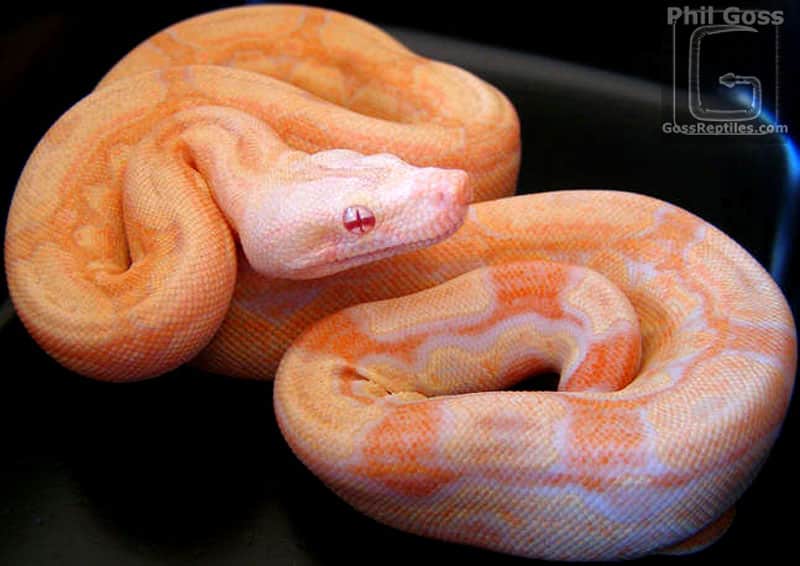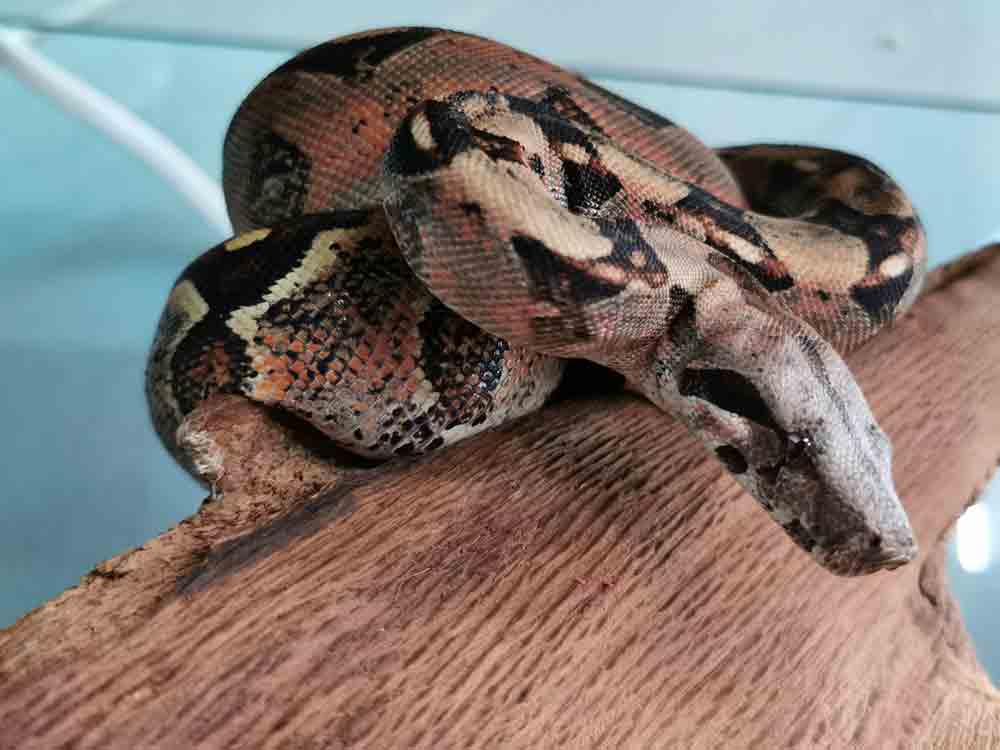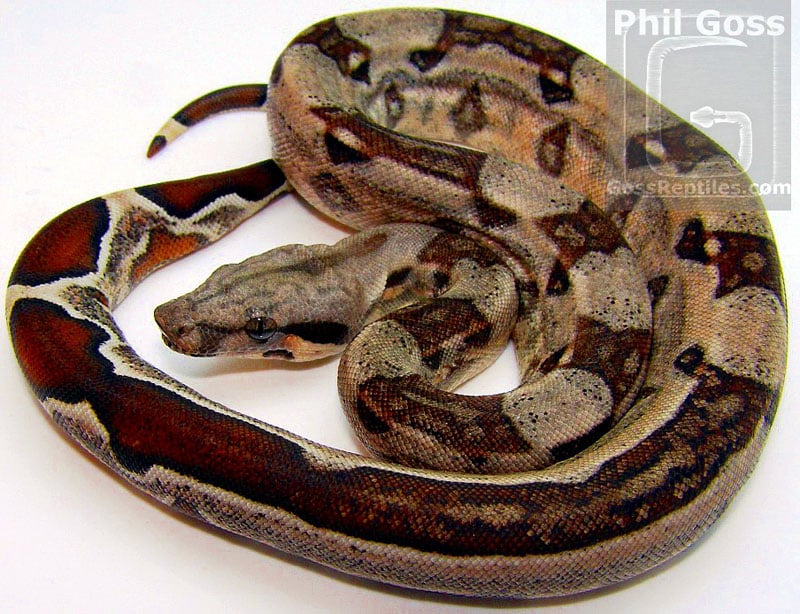Expert tips on caring for the Colombian boa constrictor.
Updated January 26, 2023. This care sheet applies specifically to the Colombian boa constrictor, but can be applied to all localities and subspecies of Boa constrictor. Please conduct further research if keeping other subspecies.
Boa Constrictor (Boa constrictor imperator)
The Colombian boa constrictor is the most widely kept boa constrictor in the pet industry (there are nine accepted subspecies of Boa constrictor, and many localities of some subspecies). Other common names include the common boa and red-tailed boa, although the true red-tailed boa is Boa constrictor constrictor, which is larger and found in countries including Suriname, Guyana, Peru and Brazil. There may be B. c. constrictor in southeastern Colombia, but these are rarely seen in the reptile world.
Colombian boas have become popular due to being docile and having more “personality,” in that they seem to be more curious about their surroundings than some other snakes. Colombian boa constrictors make great pets, and they are available in a vast array of appealing color and pattern morphs. Proper care can be provided even by beginner hobbyists, but due to their potentially large size and lengthy life span, boas are best suited for moderate- and advanced-level keepers. With reptile health and wellness prioritized, this care sheet should help ensure quality keeping of the Colombian Boa Constrictor.
Boa Constrictor Availability
Boa constrictors are readily available in the pet industry, and many breeders specialize in Colombian boa morphs. They have been bred in captivity for decades, and litters are born nearly all year. The majority of boa litters occur from May through August, so late summer and fall see the highest availability of babies. Sometimes they can be found in exotic shops or reptile shops online.

Courtesy Phil Goss
Prices vary greatly, depending on the type of boa constrictor you want, and where you purchase it. Wild-phase or normal-colored boas can sometimes be purchased for $60 to $75 at reptile shows, or $150 to $200 in retail stores. Low-color hypomelanistic (reduced black pigment) boas may be as low as $75 at reptile shows, but new and “designer” morphs can cost in excess of $5,000.
Be sure to purchase your boa from a reputable source. Look for active snakes lacking any retained shed skin, possible respiratory infection (auditory breathing can be a sign of this) or spinal kinks or deformities. Check for snake mites, which are small, black, parasites that resemble ticks.
How Big Does The Boa Constrictor Grow?
Female Colombian boa constrictors may reach 10 feet in length, though this is rare for B. c. imperator, and the average adult size for females is usually 6 to 8 feet. Males are smaller, usually 5 to 7 feet in length. Some Central American boa constrictors remain much smaller—if you would like a smaller boa constrictor, look into Central American locality types, such as those from Belize, Nicaragua, Costa Rica and Panama. Smaller subspecies include Boa c. longicauda and B. c. sabogae, though keep in mind that these localities and subspecies have not been bred in captivity as long as the Colombian boa, so they may not be as docile and could require extra attention to calm them down.

Boa constrictors grow to about 6 to 8 feet. Some grow to 10 feet in length. Photo by Alex Baranska/Shutterstock
Boa Constrictor Life Span
Boas are very long-lived reptiles. There are documented cases of captive boas living longer than 40 years; however, the average captive life span is 20 to 30 years. Please consider this carefully before bringing a boa home.
The Best Boa Constrictor Housing
Many caging options are available for boa constrictors. Reptile terrariums can be used, but reptile-specific plastic enclosures made from high-quality plastics that maintain proper humidity are much more suitable for boas than anything else. A rack system is something to consider should you advance into breeding boas, or if you plan to have many boas living with you. Custom enclosures are another option.
Young boa constrictors have simple needs; a large, beautifully decorated cage is not the best choice for them. While a new boa is acclimating, simple housing is preferred, and the enclosure should be prepared prior to your new boa’s arrival home. An appropriate first cage for a baby boa would be no larger than 30 inches long by 12 inches wide, in which it will feel very secure.
Naturally, as the young boa grows, a larger cage will be required. Boa constrictors are terrestrial and floor space is more important than height. Young boas may climb, but do so much less as they grow. Typical full-grown adult boas should be housed in cages no smaller than 4 feet long by 2 feet wide (with larger-than-average snakes in larger enclosures).
A hide box/shelter should be provided, which will allow the boa to feel safe and secure. There are many commercially manufactured types available for snake habitat products. Offer two hides, one on the warm side of the enclosure and one on the cool side. A stressed baby boa may stay on one side of the cage if only one hide is provided, which may discourage the snake from thermoregulating properly.
You may also provide rocks, sticks or other structures, but be sure they are positioned securely and free of parasites. A variety of reptile habitat accessories are available at stores or online.
Ideal Lighting and Temperature For The Boa Constrictor
Boas control their body temperature through thermoregulation, and the cage should have a warm side and a cool side. This is very important! Do not place the heat source in the center of the cage, place it at one end. Then if the boa gets too warm, it will move toward the cooler side, and if it is too cool, it will move to the warmer side. That’s thermoregulation!
The temperatures in the cool end your boa cage should not drop below 75 degrees Fahrenheit. The warm side should be 85 degrees, with a hot spot of 90 degrees provided by an under-cage heating device that will provide “belly heat.” Boa constrictors greatly prefer this, so they can coil over the rising heat.
Belly heat can be provided using various devices. Under-tank heaters are the most readily available. Heat cable and heat tape are other possibilities. Any heating device should be controlled with a proportional thermostat or rheostr. Some heat sources, especially heat tape, can get too hot for some enclosures, and they must be regulated not just for the boa’s safety, but yours, too. If using these devices, especially if you’re using a glass enclosure such as an aquarium, be sure some ventilation is provided around the heat source. If heat builds up, it can crack the bottom of a glass tank, or cause other caging materials to melt or overheat.
Overhead lighting is not usually needed. If an overhead bulb is used, it should be placed directly over the source of the belly heat. Be sure to check the temperature of your hot spot while the bulb is on. If the belly heat being provided from the under-enclosure device is not warm enough, overhead lighting will assist in maintaining a proper hot spot, but overhead lighting or an overhead heating device alone is not recommended for boas.
A low-wattage fluorescent bulb, such as the Exo Terra natural daylight reptile lamp, can be used to provide a photoperiod (day/night cycle) and to better observe your boa. Full-spectrum bulbs with UVB like the Solar Glo all in one reptile lamp, may provide physical and physiological benefits to boas, but this has not been proven. UVB lighting is not needed for the proper care of boas, and the vast majority of boa keepers do not use it. Still, it won’t harm your boa, so feel free to provide it just in case there is some benefit.
The Best Substrate For The Boa Constrictor
Boas can be kept on several types of substrate. Newspaper, aspen, white or brown butcher/wrapping paper, and cage carpet are the most often used substrates. Fir and cypress barks are also acceptable but not often used by breeders. If using cypress bark or mulch, be sure it does not become too damp as it holds humidity very well. When using aspen bedding or carpet, the cage can be spot cleaned often, with a full change occurring as needed. If using paper, the entire substrate should be changed each time cage cleaning occurs.
What To Feed Your Boa Constrictor
It is very important to allow your new boa to acclimate to its new surroundings before feeding. Never attempt to feed a new boa for at least five days after you bring it home. I assure you your new boa will be fine without food during this time. If you feed it too soon, while it may still be stressed from the move to your home, the snake may regurgitate. If this occurs, be sure your temperatures are correct, and do not attempt to feed the boa again for two weeks. The most common causes of regurgitation are improper temperature and stress from being handled, so be sure you provide proper cage temperatures and do not excessively handle boas after meals.
Never feed a new boa constrictor a meal that is larger than the snake’s mid-body girth. It should never exhibit a bulge after eating. Especially in young boas, a meal that is too large may lead to regurgitation. An established boa will handle a meal resulting in a small bulge just fine.
Pet boa constrictors should be fed only quality mice or rats. They need no additional food or supplementation. Be sure you buy your rodents from a good source to prevent disease and mites. Boas 2 years old and younger should be fed one appropriately sized rodent every seven to 10 days. Excessive feeding may lead to regurgitation, improper growth, and even premature death. Once boas near adulthood, they will thrive while being fed every 10 to 14 days. It is okay to feed your boa more or less often, but be sure to monitor weight so the boa does not become obese or underweight.
Most boa constrictors available as pets will be eating frozen/thawed prey. If you purchase one that is eating live rodents, it will often take frozen/thawed prey that is presented from a pair of tongs. Pre-killed rodents are always best, whether they are frozen/thawed or freshly killed, because live rodents may harm your boa. If your snake does not kill its prey (boas will not eat if they are not hungry or are kept under improper conditions), the rodent may bite or even kill your boa. Even if the boa does constrict its prey, the rodent may bite before it is killed. Never leave your boa unattended with live rodents.
Boa Constrictor Water and Humidity
A water bowl is a necessity. This allows your boa a place to drink and helps provide the proper humidity for your boa. The humidity in the cage should be 60 to 70 percent; use a hygrometer (humidity gauge) to track the percentage.
Hog Island Boa Constrictor Information
Tips For Breeding Boa Constrictors
Water must always be clean and should be changed as needed and the bowl cleaned. Some boa constrictors will defecate or urinate in the water, which must be cleaned immediately if this occurs. Be sure to scrub and rinse the bowl, using an antibacterial dish soap and hot water. Be sure to rinse thoroughly, and run the water bowl through your dishwasher monthly if possible. Disposable forms of water bowls, such as deli cups, are another option.
Young boas will often soak before or during a shed cycle. This aids in shedding their skin, but usually occurs only when proper cage humidity is not being met. A boa that is constantly in the water bowl usually indicates the humidity is too low, the temperature is too high, or the boa has mites.
After a shed, be sure to check the tip of your boa’s tail. Young boas will sometimes retain a small piece of shed skin there. If caught soon after the shed, this old skin is usually easy to remove by gently pulling the skin off. Always be careful when attempting this. If it’s sticking, usually a dip in warm water will make removal easy. This skin retention does not necessarily mean you have husbandry issues. Sometimes the skin simply tears before the shed is removed completely. If you notice retained skin on other areas of your boa’s body, you may need to adjust the humidity levels.
Shedding issues are usually a result of insufficient humidity. A soak or two during the shed cycle will greatly help if you are experiencing low-humidity issues. Place a quarter-inch of warm water in an appropriately sized plastic container, and place your boa inside with a secure lid in place. Then place the container in your boa’s cage, positioned so the inside of the container has a warm side and cool side. This will keep the water warm and the humidity high. Do not place it directly over the belly heat or under a basking bulb. A few holes in the lid or sides of the container will provide ventilation. Soak your boa in the container for up to an hour (two hours if you’re combating a particularly tough shed) and repeat as necessary. Be sure to check on your boa regularly, as they will often defecate while soaking. Change the water and clean the container if this occurs. At end of the shed cycle, remove the water and place a small towel in the container so your boa can rub on it to help shed its old skin.
Boa Constrictor Handling and Temperament
Boa constrictors are usually very docile and tolerate handling very well. They often seem to enjoy being held and will seek out an area on your arm or shoulders and enjoy your body warmth. They may crawl around for a few minutes before hunkering down to grab some heat.
If your boa seems to have a bad attitude, check its enclosure temperatures, humidity levels and overall husbandry. Most boas calm quickly after repeated sessions of being handled.
The boa constrictor makes a great pet for reptile hobbyists of all levels, and it remains a cornerstone in the reptile community. Personally, I believe boa constrictors are as good as it gets in the snake world.
Phil Goss has been keeping boa constrictors since 1996. You can visit his website at www.GossReptiles.com.


